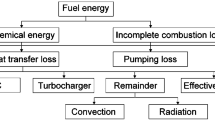Abstract
The thermal soak phase of a vehicle results from driving the vehicle at high load followed by shutting off the engine. The present work deals with the analysis and modeling of the thermal soak phase of a vehicle through temperature and heat flux measurements. Measurements are carried out on a passenger vehicle in wind tunnel S4 of Saint-Cyr-France. The underhood is instrumented by alsmot 120 surface and air thermocouples and 20 fluxmeters. Measurements are performed for three thermal functioning conditions, with the engine in operation and the front wheels positioned on the test facility with power-absorption controlled rollers. It was found that in thermal soak the temperature of certain components can increase by almost 80°C (pre-catalyst) and that of air zones by alsmot 40°C (crawl area). These components correspond to areas that heat up after stopping the engine for 3 to 24 minutes, depending on their position in the underhood and on the thermal operating point considered.
Similar content being viewed by others
Explore related subjects
Discover the latest articles and news from researchers in related subjects, suggested using machine learning.References
Alajbegovic, A., Sengupta, R. and Jansen, W. (2006). Cooling airflow simulation for passenger cars using detailed underhood geometry. SAE Paper No. 2006-01-3478.
Bendell, E., Gorlato, L. and Hauenstein, M. (2007). Experimental and numerical study of underbody drive and soak thermal conditions on the basis of a heat shield test rig. SAE Paper No. 2007-01-1780.
Chen, K., Johnson, J., Merati, P., Cooper, N. and Leong, C. (2006). Investigation of the buoyancy driven flow in a simplified underhood Part II, Numerical Study. SAE Paper No. 2006-01-1607.
Costa, E. (2003). CFD approach on underhood thermal management of passenger cars and trucks. SAE Paper No. 2003-01-3577.
Fortunato, F., Damiano, F., Matteo, L. and Oliva, P. (2005). Underhood cooling simulation for development of new vehicles. SAE Paper No. 2005-01-2046.
Foss, J., Lawrenz, A. and Norconk, M. (2005). Temperature and flow rate measurements with the thermal transient anemometer. SAE Paper No. 2005-01-2030.
Fournier, E. and Bayne, T. (2007). Under hood temperature measurements. SAE Paper No. 2007-01-1393.
Franchetta, M., Bancroft, T. and Suen, K. (2006). Fast transient simulation of vehicle underhood in heat soak. SAE Paper No. 2006-01-1606.
Franchetta, M., Suen, K., Williams, P. and Bancroft, T. (2005). Investigation into natural convection in an underhood model under heat soak condition. SAE Paper No. 2005-01-1384.
Gu, J., Ouyang, M., Lu, D., Li, J. and Lu, L. (2013). Energy efficiency optimization of electric vehicle driven by inwheel motors. Int. J. Automotive Technology 14, 5, 763–772.
Juan, T. (2008). Investigation and assessment of factors affecting the underhood cooling air flow using CFD. SAE Paper No. 2008-01-2658.
Kaushik, S. (2007). Thermal management of a vehicle’s underhood and underbody using appropriate math-based analytical tools and methodologies. SAE Paper No. 2007-01-1395.
Khaled, M., Al Shaer, A., Hachem, F., Harambat, F. and Peerhossaini, H. (2012). Effects of ground vehicle inclination on underhood compartment cooling. Int. J. Automotive Technology 13, 6, 895–904.
Khaled, M., El Hage, H., Harambat, F. and Peerhossaini, H. (2012). Some innovative concepts for car drag reduction: A parametric analysis of aerodynamic forces on a simplified body. J. Wind Engrg. Ind. Aero., 108, 36–47.
Khaled, M., Garnier, B., Harambat, F. and Peerhossaini, H. (2010). A new method for simultaneous measurement of convective and radiative heat flux in car underhood applications. Meas. Sci. Tech., 21, 025903.
Khaled, M., Harambat, F. and Peerhossaini, H. (2009). A quantitative method for the assessment of car inclination effects on thermal management of the underhood compartment. J. Therm. Sci. Engrg. Appl. ASME, 1, 1–5.
Khaled, M., Harambat, F. and Peerhossaini, H. (2010). Temperature and heat flux behavior of complex flows in car underhood compartment. Heat Trans. Engrg., 31, 1–11.
Khaled, M., Harambat, F. and Peerhossaini, H. (2010). Underhood thermal management: Temperature and flux measurements and physical analysis. Appl. Therm. Engrg., 30, 590–598.
Khaled, M., Harambat, F. and Peerhossaini, H. (2011). Analytical and empirical determination of thermal performance of louvered heat exchanger — effects of air flow statistics. Int. J. Heat Mass Transf., 54, 356–365.
Khaled, M., Harambat, F. and Peerhossaini, H. (2011). Towards the control of car underhood thermal conditions. Appl. Therm. Engrg., 31, 902–910.
Khaled, M., Harambat, F., El Hage, H. and Peerhossaini, H. (2011). Spatial optimization of underhood cooling module — Towards an innovative control approach. Appl. Energ., 88, 3841–3849.
Kini, S. and Thoms, R. (2009). Multi-domain meshes for automobile underhood applications. SAE Paper No. 2009-01-1149.
Mansor, S. and Passmore, M. A. (2013). Effect of rear slant angle on vehicle crosswind stability simulation on a simplified car model. Int. J. Automotive Technology 14, 5, 701–706.
Merati, P., Cooper, N., Leong, C., Chen, K. and Johnson, J. (2006). Investigation of the buoyancy driven flow in a simplified underhood Part I, PIV and temperature measurements. SAE Paper No. 2006-01-1608.
Weidmann, E., Binner, T. and Reister, H. (2008). Experimental and numerical investigations of thermal soak. SAE Paper No. 2008-01-0396.
Weidmann, E., Wiedemann, J., Binner, T. and Reister, H. (2005). Underhood temperature analysis in case of natural convection. SAE Paper No. 2005-01-2045.
Author information
Authors and Affiliations
Corresponding author
Rights and permissions
About this article
Cite this article
Khaled, M., Elrab, M.G., Habchi, C. et al. Analysis and modeling of the thermal soak phase of a vehicle — Temperature and heat flux measurements. Int.J Automot. Technol. 16, 221–229 (2015). https://doi.org/10.1007/s12239-015-0024-3
Received:
Revised:
Accepted:
Published:
Issue Date:
DOI: https://doi.org/10.1007/s12239-015-0024-3




